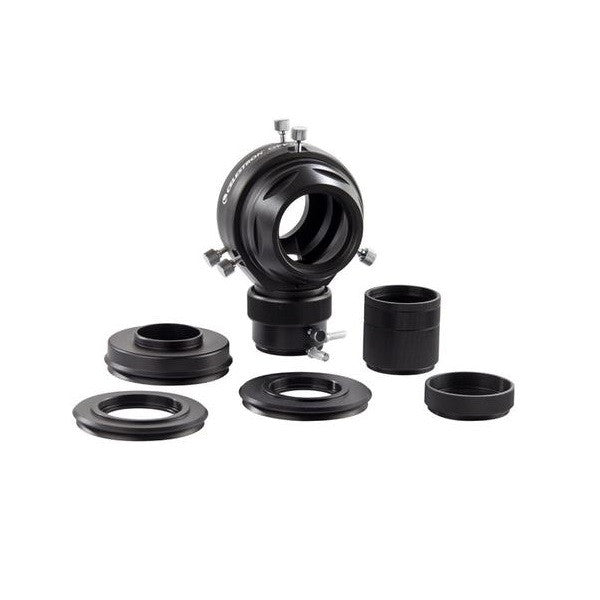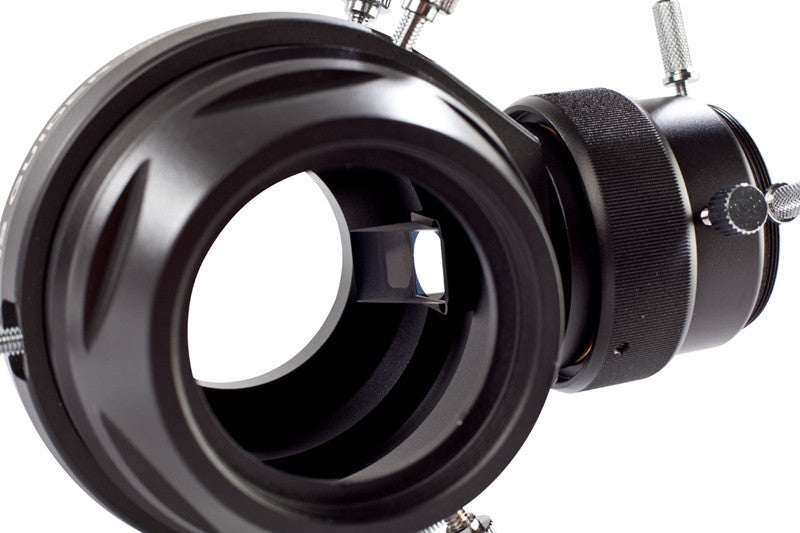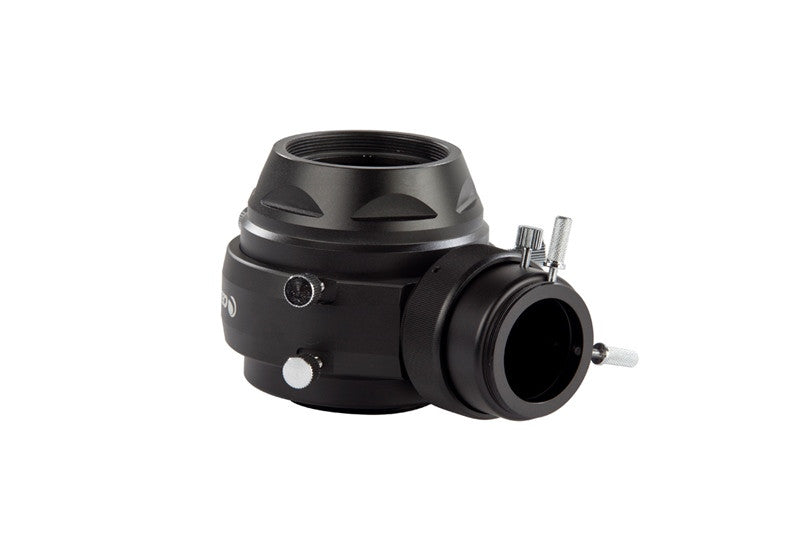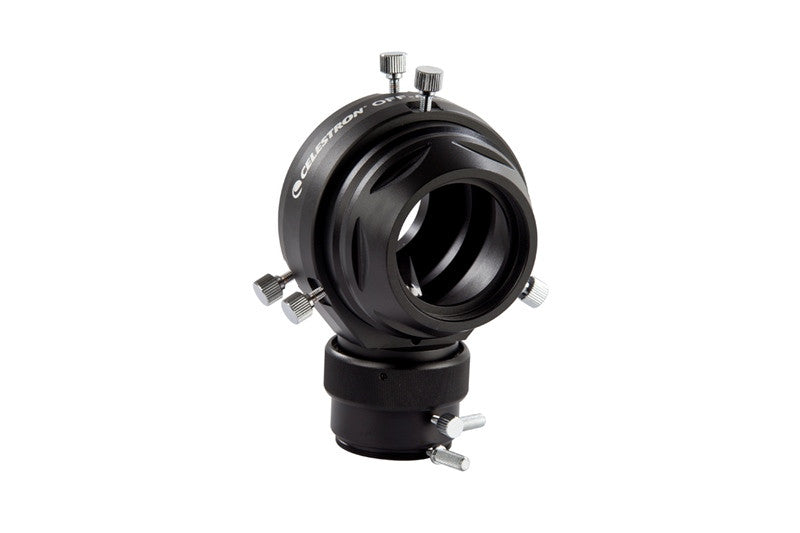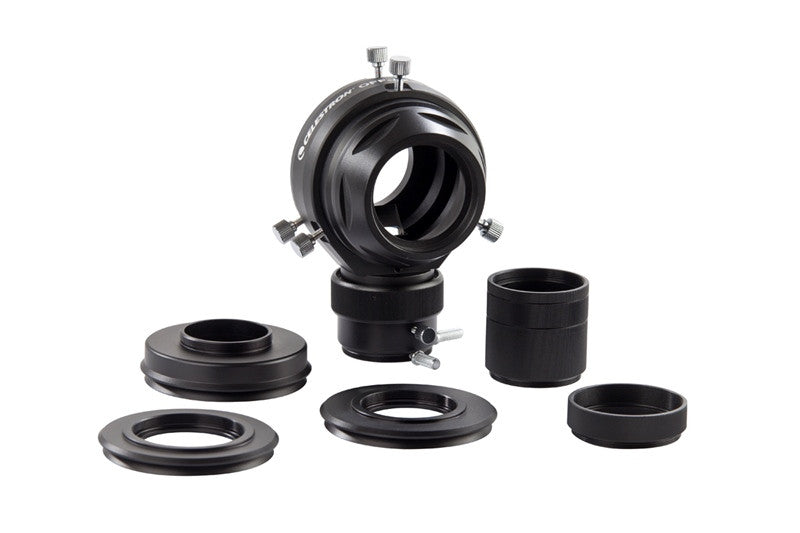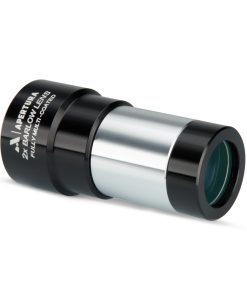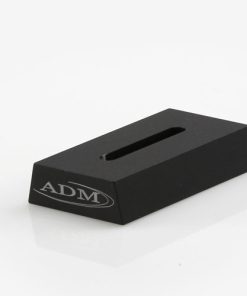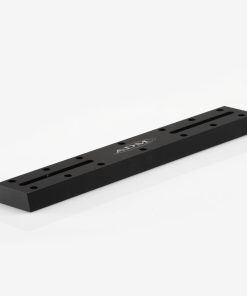Celestron Deluxe Off-Axis Guider – 93648 Celestron
$ 299,95 $ 119,98
Serious astrophotographers know that an off-axis guider is the best way to ensure perfect tracking accuracy over long exposure times. Unlike a separate guide scope, which can never be 100% perfectly aligned with the telescope, the off-axis guider uses the main telescope optics. This means you’ll correct for tracking errors, opto-mechanical errors, and flexure. It’s a difference you can see in your final images, with round, pinpoint stars across the field of view.
But in the past, off-axis guiders were complicated and difficult to use. Celestron has solved those problems with the most user-friendly off-axis guider we’ve seen to date.
What makes this guider different? The massive 12.5mm multi-coated prism. Other off-axis guiders with inferior prisms provided so little light to the autoguider that locating a guide star was challenging and time consuming. This huge prism perfectly intercepts a small portion of the light coming through the telescope optics and deflects it up to your autoguider. Its huge size, fully multicoated optics, and aluminized backing bring in enough light that it’s easy to locate an adequate guide star.
Even though the prism is large, it intercepts light outside of your camera’s imaging circle, so there’s no loss in image quality. You can adjust the exact positioning of the prism to bring it closer to the imaging circle when using smaller sensors like that of a DSLR.
The guider also features a fixed-orientation helical focuser that works perfectly with any autoguider. A smooth adjustment knob makes it easy to bring your guide star into focus without changing or twisting the autoguider camera’s orientation.
The Celestron Off-Axis Guider goes a step beyond most competitors, providing a wide variety of spacers and adapters to ensure you space your camera exactly on your telescope’s focal plane, even accounting for the width of the guider. Other manufacturers don’t provide these spacers, adding cost and complexity to your final setup. Each guider includes an SCT/EdgeHD adapter, female M48, female M42 (t-thread), male M48, male M42 (t-thread), and 3 T-thread spacers.
This elegant solution will allow you to track exposures confidently for minutes at a time while simplifying your overall setup and reducing setup time.
Quick Shipping and Professional Packaging
Due to our longstanding partnership with UPS FedEx DHL as well as other major international carriers, we are able to provide various shipping options. Our warehouse personnel are well trained and will be able to pack your goods in accordance with the exact and precise specifications. Your goods are thoroughly checked and securely secured prior to shipment. Everyday we deliver hundreds of packages to our customers from all over the world. Our determination to be the biggest online retailer in the world is shown by this. The warehouses are located situated in Europe in the same way as they are in the USA.
Note: Orders containing multiple items will have a separate processing period for each item.
We will carefully examine all products before they are shipped. Today, the majority of orders will be delivered within 48 hours. The delivery time will be between 3-7 working days.
Returns
We don't manage the stock at our warehouse and factory. The actual inventory may fluctuate at any time. It's possible that you may not receive your order once it's been placed.
Our policy is for 30 days. We are unable to return or exchange your purchase after 30 days since the purchase.
In order for your item to be eligible for return the item must not be opened and in the condition you received it. It must also remain in the original packaging.
Related products
Telescope Accessories
ADM Accessories CGEM Knob Upgrade – Orange Tripod Knob Set – CGEM-TKS-OR ADM
Telescope Accessories
ADM Mini Electronics Pier Knobs for Celestron CGE Pro Mount – CGE-PRO-MP ADM
Telescope Accessories
Telescope Accessories
ADM V Series Dovetail Plate for Celestron 9.25″ SCT – Orange – VC925-O ADM
Telescope Accessories
ADM Accessories Vixen Style Dovetail for Meade 8″ SCT – VM8 ADM
Telescope Accessories
Apertura 1.25″ Neutral Density Filter 13% Transmission – ND96-0.9 – A-ND91 Apertura
Telescope Accessories
Apertura 1.25″ Chrome Barrel for 1.25″ Eyepieces, Barlows & Diagonals – 125B Apertura
Telescope Accessories
Apertura 0.75X 2″ Focal Reducer For RC Telescopes – A-RCR Apertura
Telescope Accessories
ADM Accessories Tripod Knob Set for Losmandy G11 & Celestron CI700 Mounts – Orange – TKS-OR ADM
Telescope Accessories
ADM Accessories Vixen Style Universal Dovetail Telescope Mounting Bar – 14″ Long – VDUP14 ADM
Telescope Accessories
Telescope Accessories
ADM Accessories CGEM Counterweight Bar 22 Inches – CGEM-CW ADM
Telescope Accessories
ADM Accessories CGEM Knob Upgrade – Two Orange Anodized Rosette Saddle Knobs – CGEM-SAD-OR ADM
Telescope Accessories
ADM Replacement Azimuth Knobs for Celestron Advanced VX Mount – VX-AZ ADM
Telescope Accessories
ADM Accessories Vixen Style Dovetail for Celestron 11″ SCT – VC11 ADM
Telescope Accessories
ADM V Series Universal Dovetail with 150 mm Rings – VDUPR-150 ADM
Telescope Accessories
ADM Accessories CGEM Knob Upgrade – Two Orange Anodized Spreader Bar Knobs – CGEM-SB-OR ADM
Telescope Accessories
ADM Accessories Tripod Knob Set for Losmandy G11 & Celestron CI700 Mounts – Blue – TKS-BL ADM
Telescope Accessories
ADM Replacement Spreader Bar Knobs for Celestron Advanced VX Mount – VX-SB ADM
Telescope Accessories
ADM Accessories Vixen Style Dovetail for Celestron 9.25″ SCT – VC925 ADM
Telescope Accessories
Telescope Accessories
ADM Accessories CGEM Knob Upgrade – Polar Hole Plug – CGEM-PL-OR ADM
Telescope Accessories
ADM Accessories Vixen Style Universal Dovetail Telescope Mounting Bar – 3″ Long – VDUP3 ADM
Telescope Accessories
Telescope Accessories
ADM Accessories Vixen Style Universal Dovetail Telescope Mounting Bar – 11″ Long – VDUP11 ADM
Telescope Accessories
ADM Accessories Celestron CGX Side-By-Side Adapter – CGX-SBS ADM
Telescope Accessories
ADM V Series Universal Dovetail with 125 mm Rings – VDUPR-125 ADM
Telescope Accessories
ADM Accessories Mini Dovetail Bars for Mounting – MDS-M8 ADM
Telescope Accessories
ADM Accessories CGEM Knob Upgrade – Altitude Locking Knob – CGEM-T-OR ADM
Telescope Accessories
ADM V Series Dovetail Bar for Celestron 8″ SCT – Orange Anodized – VC8-O ADM
Telescope Accessories
ADM Tripod Knob Set for Celestron CGE Pro Mount – CGE-PRO-TKS ADM
Telescope Accessories
ADM Tripod Knob Set for Celestron CGEM DX Mount – CGEM-DX-TKS ADM
